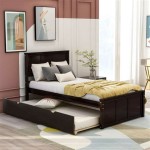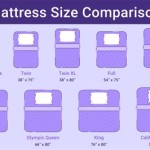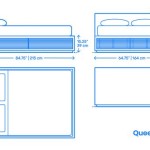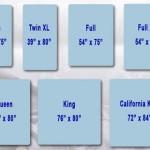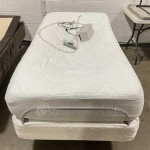Bunk Bed with King Size Bottom: Optimizing Space and Comfort
The bunk bed, traditionally associated with children’s rooms and dormitories, has evolved significantly in recent years. One notable adaptation is the bunk bed featuring a king-size bottom, offering a compelling solution for maximizing space while providing comfortable sleeping arrangements for adults or multiple individuals. This configuration addresses the need for efficient use of square footage, particularly in smaller homes, apartments, and vacation properties. The design facilitates varied sleeping arrangements, accommodating couples on the lower level and individuals on the upper berth. This article explores the advantages, considerations, and design elements associated with a bunk bed incorporating a king-size bottom.
The appeal of a bunk bed with a king-size bottom lies in its ability to blend functionality with a specific type of comfort. Traditional bunk beds are often designed with twin or full-size mattresses, potentially insufficient for adults or those who prefer more sleeping space. The king-size bottom bunk directly addresses this limitation, offering the expansive dimensions of a standard king mattress (approximately 76 inches wide by 80 inches long). This provides ample room for couples to sleep comfortably, particularly beneficial in situations where a separate guest room isn't feasible. The upper bunk, typically a twin or full size, can then be reserved for a single sleeper, children, or guests.
Key Advantages of King-Size Bottom Bunk Beds
The primary advantage of a bunk bed with a king-size bottom is its efficient use of space. In smaller apartments, studios, or guest rooms, every inch of floor space matters. Replacing a conventional bed setup with a vertically oriented bunk bed frees up valuable floor area for other furniture, activities, or general movement. This is particularly useful in rooms that serve multiple purposes, such as a home office that occasionally transforms into a guest bedroom. The elevated upper bunk allows for storage solutions underneath, further enhancing space utilization. Drawers, shelves, or open storage compartments can be integrated into the design to accommodate clothing, bedding, or personal belongings.
Versatility is another key benefit. Unlike a traditional bed frame that is fixed in its configuration, a king-size bottom bunk bed offers customizable sleeping arrangements. This flexibility makes it ideal for families with children, guest rooms accommodating couples and singles, or vacation rentals catering to diverse groups. The king-size bottom can comfortably accommodate two adults, while the upper bunk can house a child or single guest. This adaptability ensures that the sleeping arrangements can be tailored to the specific needs of the occupants at any given time. The design can also be beneficial for individuals sharing a room who desire a degree of separation and privacy.
Furthermore, these bunk beds often present a cost-effective sleeping solution. Purchasing a single bunk bed structure with a king-size bottom is typically less expensive than buying separate beds or investing in space-saving furniture like a murphy bed. This can be a significant factor for individuals or families operating on a budget. The long-term value is also enhanced by the bed’s durability and adaptability, making it a worthwhile investment that can serve multiple purposes over time. In addition, the bunk bed can be disassembled and reassembled if the need arises, providing portability and flexibility during relocations.
Design and Style Considerations
Bunk beds with king-size bottoms are available in a variety of styles and materials, ranging from modern metal frames to rustic wooden designs. Metal frames offer a sleek, minimalist aesthetic that complements contemporary décor styles, while wooden frames provide a warmer, more traditional look. The choice of material depends on the overall aesthetic of the room and personal preferences. It is essential to select a material that is durable and capable of supporting the weight of multiple occupants. Look for frames constructed from sturdy materials like solid wood or heavy-gauge steel.
When choosing a bunk bed, the height of the ceiling is a crucial factor. The upper bunk requires sufficient headroom for the occupant to sit up comfortably without hitting the ceiling. A minimum ceiling height of eight feet is generally recommended, although taller individuals may require even more space. The height of the lower bunk should also be considered, especially for taller individuals who will be sleeping there. If the lower bunk is too low, the occupant may feel cramped or restricted. Adjustable bed frame heights can sometimes mitigate this issue.
Safety is paramount in the design of any bunk bed. The upper bunk should be equipped with sturdy guardrails to prevent falls. The ladder or staircase leading to the upper bunk should be securely attached and easy to climb. Ensure there is adequate lighting near the ladder for safe nighttime access. Regularly inspect the bed frame for any signs of wear or damage, such as loose screws or cracks in the wood. Following the manufacturer's instructions for assembly and weight limits is critical. It's also advisable to prohibit young children from playing on or climbing the bunk bed unsupervised.
Factors in Choosing the Right Bunk Bed
Before purchasing a bunk bed with a king-size bottom, several factors should be taken into account to ensure it meets specific needs and preferences. The size of the room is a primary consideration. Measure the available space to ensure the bed fits comfortably without overcrowding the room. Consider the placement of windows, doors, and other furniture to optimize the layout. A cramped room can diminish the functionality and appeal of the bunk bed, negating its space-saving benefits. A floor plan may be helpful in visualizing the placement.
The weight capacity of the bunk bed is another crucial factor, particularly for the upper bunk. Ensure that the bed frame is designed to support the weight of the occupants who will be sleeping on it. Overloading the bed can compromise its structural integrity and pose a safety hazard. The manufacturer's specifications typically provide information on weight limits. Adhering to these limits is essential for the longevity and safety of the bunk bed. Select a bed frame that is rated to handle the combined weight of the occupants and their bedding.
Lastly, the aesthetic of the bunk bed should complement the existing décor of the room. Consider the color, style, and material of the bed frame. Choose a design that blends seamlessly with the overall look and feel of the room. A well-coordinated bunk bed can enhance the visual appeal of the space and create a more harmonious environment. Explore different finishes and styles to find a bunk bed that aligns with personal taste and the existing furniture. Bunk beds are available in modern, traditional, rustic, and minimalist styles, allowing for a wide range of aesthetic choices.
The integration of storage solutions is another aspect to consider. Some bunk beds incorporate built-in drawers, shelves, or cabinets, providing additional storage space for clothing, bedding, or personal belongings. These features can be particularly useful in smaller rooms where space is at a premium. Consider opting for a bunk bed with integrated storage to maximize functionality and minimize clutter. The added storage can also help to keep the room organized and tidy.
The ease of assembly is also important. A bunk bed that is difficult to assemble can be frustrating and time-consuming. Look for models that come with clear and concise instructions and all the necessary hardware. Consider reading online reviews to assess the assembly process. If possible, opt for a bunk bed that can be easily assembled by one or two people. Professional assembly services are also available for those who prefer not to assemble the bed themselves.
In conclusion, a bunk bed with a king-size bottom represents a compelling solution for those seeking to maximize space and comfort. By carefully considering the advantages, design elements, and key factors outlined in this guide, individuals can make informed decisions and select a bunk bed that meets their specific needs and complements their living space. The evolution of the bunk bed design allows for a broader application to a wider range of living situations.

Twin Over King L Shaped Bunk Bed Adultbunkbeds Com

Florenville Bunk Bed Frame Double Decker 2 Sizes Small Queen Option Mattress

King Triple Bunk Bed Heavy Duty Beds For Adults Adultbunkbeds Com

Riley King Single Over Queen Bunk Bed Beds Australia

King Bunk Bed For Adults Heavy Duty Space Saving Over Adultbunkbeds Com

Triple Tree Kids Modern Wood Twin Over King Bunk Bed With Trundle White

Hb Rooms Binary Bunk Bed 1007 P Kids Haven

The Stairway Wooden Bunk Beds Forever Redwood

Nash King Single Over Queen Loft Bed Bunk Beds Australia

Twin Over King Bunk Bed With Size Trundle Bottom Can Be Extendable Into 3 In 1 Wood Frame Drawer Storage Staircase


